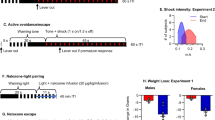Abstract
To assess the effects of training dose on the discriminative stimulus properties of LSD, groups of rats (eight/group) were trained to discriminate each of three doses of LSD (0.02, 0.08 or 0.32 mg/kg) from saline. This was accomplished by using a method of progressively altering dose (“fading”). Dose-response tests revealed that the three LSD cues were specific to the dose used during training and that, as the training dose declined, the slope of the LSD dose-response curve became less steep. Substitution tests with direct serotonin (5-HT) agonists (quipazine, MK-212, 5-methoxy-N,N-dimethyltryptamine) and antagonism tests with central 5-HT antagonists (methiothepin and cyproheptadine) indicated that 5-HT is involved in mediating the in vivo effects of LSD and that training dose co-determines (along with the dose of the test compound) the extent of substitution or antagonism. In addition, substitution tests with the peripherally-active 5-HT agonist 5-methoxytryptamine and 5-HT antagonist xylamidine suggested that the peripheral serotonergic actions of LSD may be involved (in part) in the low dose (0.02 mg/kg) LSD cue. In contrast to 5-HT, dopamine (DA) did not appear to be involved in the discriminative stimulus properties of LSD, because no significant dose or group effects were seen during tests with the DA agonists apomorphine and d-amphetamine or the DA antagonist haloperidol.
Similar content being viewed by others
References
Appel JB, White FJ, Kuhn DM (1978) The use of drugs as discriminative stimuli in behavioral pharmacodynamics. In: Colpaert FC, Rosecrans JA (eds) Stimulus properties of drugs: ten years of progress. Elsevier/North Holland Biomedical, Amsterdam, pp 7–29
Cameron OG, Appel JB (1973) A behavioral and pharmacological analysis of some discriminable properties of d-LSD in rats. Psychopharmacologia 33:117–134
Clineschmidt BV, McGuffin JC (1978) Pharmacological differentiation of the central 5-hydroxytryptamine-like actions of MK-212 [6-chloro-2-(1-piperazinyl)-pyrazine], p-methoxyamphetamine and fenfluramine in an in vivo model system. Eur J Pharmacol 50:369–375
Colpaert FC, Niemegeers CJE, Janssen PAJ (1980a) Factors regulating drug cue sensitivity: limits of discriminability and the role of a progressively decreasing dose in fantanyl-saline discrimination. J Pharmacol Exp Ther 212:474–480
Colpaert FC, Niemegeers CJE, Janssen PAJ (1980b) Factors regulating drug cue sensitivity: the effects of training dose in fentanyl-saline discrimination. Neuropharmacology 19:705–713
Colpaert FC, Rosecrans JA (1978) Stimulus properties of drugs: ten years of progress. Elsevier/North Holland Biomedical, Amsterdam
Copp FC, Green AF, Randall AW, Sim MF (1967) New peripheral antagonists of 5-hydroxytryptamine. Nature 214:200–201
Dunnett CW (1964) New tables for multiple comparisons with a control. Biometrics 20:482–491
Ernst AM (1967) Mode of action of apomorphine and dexamphetamine on gnawing compulsion in rats. Psychopharmacologia 10:316–323
Fog R (1969) Stereotyped and non-stereotyped behavior in rats induced by various stimulant drugs. Psychopharmacologia 14:299–304
Fuller RW (1980) Pharmacology of central serotonin neurons. Ann Rev Pharmacol Toxicol 20:111–127
Glennon RA, Rosecrans JA (1981) Speculations on the mechanism of action of hallucinogenic indolealkylamines. Neurosci Biobehav Rev 5:197–207
Green AR, Hughes JP, Tordoff AFC (1975) The concentration of 5-methoxytryptamine in rat brain and its effects on behavior following its peripheral injection. Neuropharmacology 14:601–606
Green AR, Koslow SH, Costa E (1973) Identification and quantification of a new indolealkylamine in rat hypothalamus. Brain Res 51:371–374
Hirschhorn ID, Rosecrans JA (1974) A comparison of the stimulus effects of morphine and lysergic acid diethylamide (LSD). Pharmacol Biochem Behav 2:361–366
Jarbe TUC, Rollenhagen C (1978) Morphine as a discriminative cue in gerbils: drug generalization and antagonism. Psychopharmacology 58:271–275
Janssen PAJ (1967) The pharmacology of haloperidol. Int J Neuropsychiat 3:10–18
Kelley PH, Iversen LL (1975) LSD as an agonist at mesolimbic dopamine receptors. Psychopharmacologia 45:221–224
Keppel G (1973) Design and analysis: a researcher's handbook. Prentice-Hall, Englewood Cliffs
Kuhn DM, White FJ, Appel JB (1978) The discriminative stimulus properties of LSD: mechanism of action. Neuropharmacology 17:257–263
Litchfield JT, Wilcoxin F (1949) A simplified method for evaluating dose-effect experiments. J Pharmacol Exp Ther 96:99–113
Overton DA (1979) Drug discrimination training with progressively lowered doses. Science 205:720–721
Pieri L, Pieri M, Haefely W (1974) LSD as an agonist of dopamine receptors in the striatum. Nature 252:586–588
Rosecrans JA, Glennon RA (1979) Drug-induced cues in studying mechanisms of drug action. Neuropharmacology 18:981–989
Rosecrans JA, Krynock GM, Newlon PG, Chance WT, Kallman MJ (1978) Central mechanisms of drugs as discriminative stimuli: involvement of serotonin pathways. In: Colpaert FC, Rosecrans JA (eds) Stimulus properties of drugs: ten years of progress. Elsevier/North Holland Biomedical, Amsterdam, pp 83–98
Shannon HE, Holtzman SG (1979) Morphine training dose: a determinant of stimulus generalization to narcotic antagonists in the rat. Psychopharmacology 61:239–244
Teal JJ, Holtzman SG (1980) Discriminative stimulus effects of cyclazocine in the rat. J Pharmacol Exp Ther 212:368–376
White FJ, Simmons MA, West KB, Holohean AM, Appel JB (1980) The effect of serotonin depletion on the discriminability of LSD. Pharmacol Biochem Behav 13:569–574
Winter JC (1978) Stimulus properties of phenylethylamine hallucinogens and lysergic acid diethylamide: the role of 5-hydroxytryptamine. J Pharmacol Exp Ther 204:416–423
Author information
Authors and Affiliations
Rights and permissions
About this article
Cite this article
White, F.J., Appel, J.B. Training dose as a factor in LSD-saline discrimination. Psychopharmacology 76, 20–25 (1982). https://doi.org/10.1007/BF00430748
Received:
Issue Date:
DOI: https://doi.org/10.1007/BF00430748




